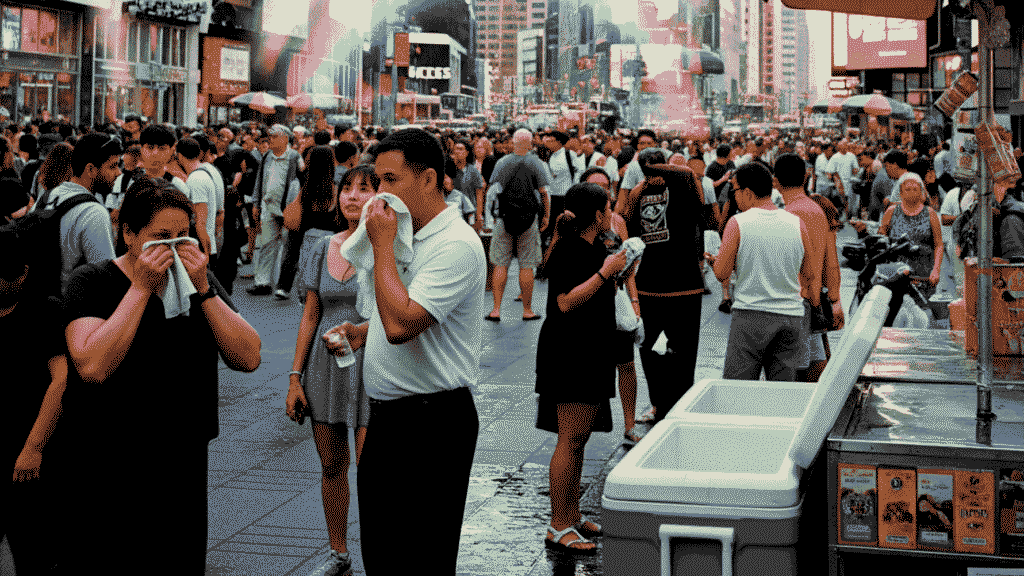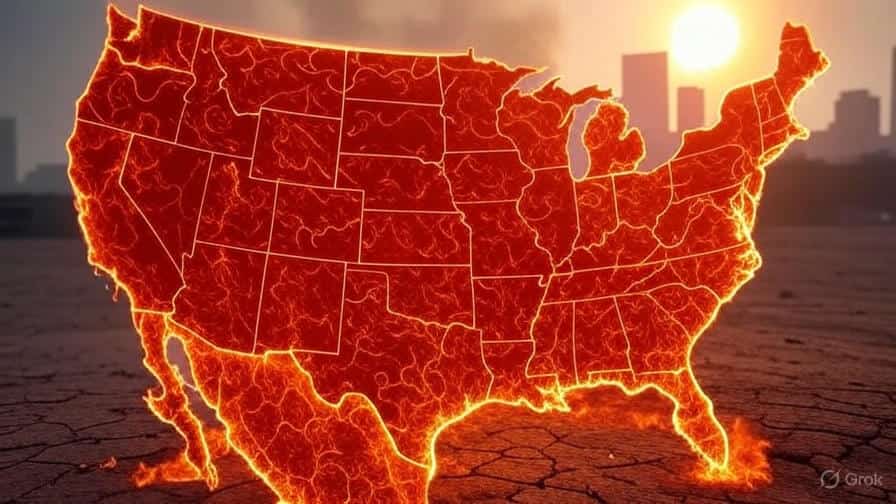
The 2025 heat wave USA is sweeping across the nation, bringing record-breaking temperatures and posing serious health risks to millions. From the Northeast to the Midwest, this extreme weather event is testing resilience and highlighting the need for preparedness. This article dives into the causes, safety protocols, daily life impacts, and actionable steps for individuals and the government to mitigate the 2025 heat wave USA effects. Stay informed to protect yourself and your loved ones.
What’s the Reason Behind the 2025 Heat Wave USA?
The 2025 heat wave USA is driven by a combination of climate change and natural weather patterns. Rising global temperatures, fueled by greenhouse gas emissions, have increased the frequency and intensity of heat waves. A persistent heat dome—a high-pressure system trapping warm air—has intensified the situation, particularly along the East Coast and Midwest. Urban heat islands, where cities absorb and retain heat due to concrete and lack of greenery, are exacerbating conditions. This year’s early summer heat, with over 190 million Americans experiencing temperatures above 90°F, reflects these trends, making the 2025 heat wave USA a critical public health concern.
Safety Protocols Americans Should Follow for Heat Wave
To combat the 2025 heat wave USA, Americans should adopt these safety measures:
- Stay Hydrated: Drink at least ¾ gallon of water daily, more if active, and avoid sugary or alcoholic drinks. Check urine color—dark yellow indicates dehydration.
- Seek Cooling: Use air conditioning or visit public cooling centers like libraries and malls. If AC isn’t available, take cool showers or use damp cloths on the skin.
- Limit Exposure: Avoid outdoor activities during peak heat (10 a.m. to 4 p.m.). Wear lightweight, loose-fitting clothing and apply sunscreen to prevent sunburn, which hinders heat release.
- Check on Vulnerable Groups: Monitor children, the elderly, and pets—never leave them in parked cars, where temperatures can soar to 120°F in minutes.
- Recognize Emergencies: Know when to call 911 for heat stroke, indicated by confusion or fainting.
How the 2025 Heat Wave USA Impacts Daily Life
The 2025 heat wave USA is disrupting routines across the nation:
- Health Risks: Increased emergency room visits, with 2023 data showing a ninefold rise in Seattle during a similar event, signal a growing burden on healthcare systems.
- Work and Productivity: Outdoor workers, especially agricultural and construction crews, face unsafe conditions, with heat stress doubling unsafe workdays projected by mid-century.
- Infrastructure Strain: Power outages from overloaded grids and road buckling (e.g., South Dakota incidents) disrupt transportation and commerce.
- Education: Schools without AC struggle, with studies linking heat to learning losses in children.
- Food and Economy: Crop damage and livestock stress raise food prices, hitting low-income families hardest.

Actions Americans Should Take
Individuals can take proactive steps to survive the 2025 heat wave USA:
- Prepare Kits: Assemble go-kits with water, electrolytes, and medicine for power outages.
- Community Support: Check on neighbors, especially the elderly, and share cooling resources.
- Adapt Homes: Use window reflectors, weather-stripping, and fans (effective below 95°F) to stay cool.
- Plan Ahead: Follow local heat alerts from the National Weather Service and adjust schedules to avoid peak heat.
Actions the Government Should Take
The government plays a crucial role in addressing the 2025 heat wave USA:
- Early Warning Systems: Enhance National Weather Service forecasts and establish heat domes as disaster triggers for funding.
- Infrastructure Upgrades: Fund cool roofs, green spaces, and resilient materials for roads and buildings to combat urban heat islands.
- Public Health Measures: Declare heat emergencies to mobilize resources, train healthcare workers on heat illnesses, and open cooling centers.
- Workplace Safety: Finalize OSHA heat standards to protect outdoor workers.
- Climate Action: Reduce emissions to slow long-term warming.
How Americans Can Stay Safe
To stay safe during the 2025 heat wave USA:
- Monitor Weather: Use apps or local news for real-time updates on heat indices.
- Cooling Access: Spend time in air-conditioned spaces daily, even for a few hours.
- Pet Care: Provide pets with shaded areas and water, avoiding hot pavement walks.
- Medical Preparedness: Consult doctors if on medications affecting heat tolerance, and keep emergency contacts handy.
Major Symptoms of Heat Wave-Related Illnesses
Recognizing symptoms is key to surviving the 2025 heat wave USA:
- Heat Cramps: Muscle spasms, heavy sweating—move to a cool place and rehydrate.
- Heat Exhaustion: Weakness, dizziness, nausea—rest in a cool area, drink water, and seek medical help if symptoms worsen.
- Heat Stroke: Confusion, rapid pulse, fainting—call 911 immediately, move to shade, and cool with wet cloths or ice packs.
National Weather Service Guidelines for the 2025 Heat Wave USA
The National Weather Service (NWS) provides critical guidelines to help Americans navigate the 2025 heat wave USA safely. They recommend drinking plenty of water, even if not thirsty, to avoid dehydration, and wearing lightweight, loose-fitting, light-colored clothing to reflect heat. Staying indoors in air-conditioned spaces as much as possible, especially during peak heat hours (10 a.m. to 4 p.m.), is advised, with alternatives like public cooling centers if home AC is unavailable. The NWS urges checking on relatives, neighbors, and the elderly, particularly those living alone, and avoiding strenuous outdoor activities. They also emphasize never leaving children or pets in parked vehicles, where internal temperatures can rise rapidly. For heat alerts, the NWS issues Excessive Heat Warnings when heat index values reach 105°F or higher during the day and 75°F or higher at night for at least 48 hours, signaling the need for immediate action. These guidelines, tailored to regional climates, are designed to reduce heat-related illnesses and deaths.
Conclusion
The 2025 heat wave USA is a wake-up call for individuals and policymakers alike. By understanding its causes, following safety protocols, adapting daily life, and taking collective action, Americans can mitigate its impact. Stay informed, stay cool, and stay safe—check back at usamainland.com for updates on the 2025 heat wave USA as it unfolds.



